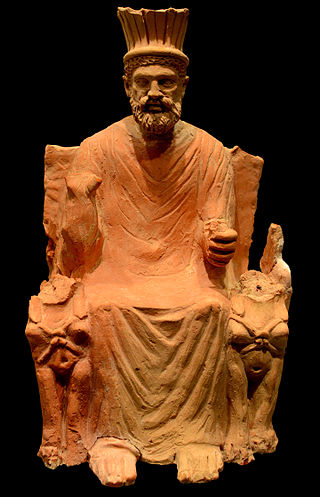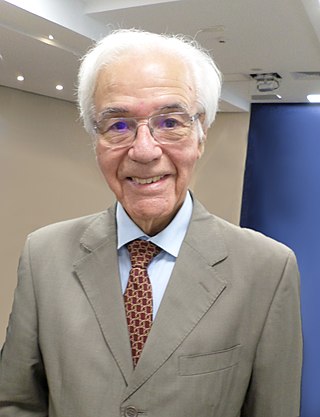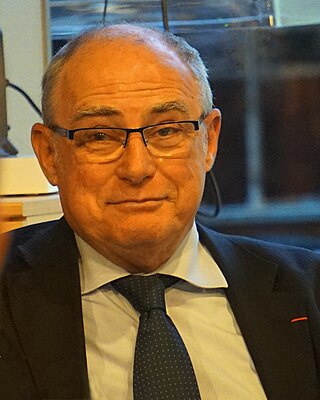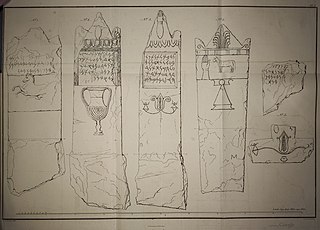Related Research Articles

Charles-Jean-Melchior de Vogüé was a French archaeologist, diplomat, and member of the Académie française in seat 18.

Baal Hammon, properly Baʿal Ḥammon or Baʿal Ḥamon, meaning "Lord Hammon", was the chief god of Carthage. He was a weather god considered responsible for the fertility of vegetation and esteemed as King of the Gods. He was depicted as a bearded older man with curling ram's horns. Baʿal Ḥammon's female cult partner was Tanit.

Jean-Jacques Barthélemy was a French scholar who became the first person to decipher an extinct language. He deciphered the Palmyrene alphabet in 1754 and the Phoenician alphabet in 1758.

The Nora Stone or Nora Inscription is an ancient Phoenician inscribed stone found at Nora on the south coast of Sardinia in 1773. Though it was not discovered in its primary context, it has been dated by palaeographic methods to the late 9th century to early 8th century BCE and is still considered the oldest Phoenician inscription found anywhere outside of the Levant.

Bodashtart was a Phoenician ruler, who reigned as King of Sidon, the grandson of King Eshmunazar I, and a vassal of the Achaemenid Empire. He succeeded his cousin Eshmunazar II to the throne of Sidon, and scholars believe that he was succeeded by his son and proclaimed heir Yatonmilk.

M'hamed Hassine Fantar is a professor of Ancient History of Archeology and History of Religion at Tunis University.

The Ksour Essef cuirass is an ancient triple-disc cuirass found in a Punic tomb in 1909 not far from Ksour Essef, Tunisia.

The Libyco-Punic Mausoleum of Dougga is an ancient mausoleum located in Dougga, Tunisia. It is one of three examples of the royal architecture of Numidia, which is in a good state of preservation and dates to the second century BC. It was restored by the government of French Tunisia between 1908 and 1910.

André Laronde was a French historian and archaeologist. He was a specialist of Greek settlements in Cyrenaica.

Maurice Sartre is a French historian, an Emeritus professor of ancient history at the François Rabelais University, a specialist in ancient Greek and Eastern Roman history, especially the Hellenized Middle East, from Alexander to Islamic conquests.

Odaenathus, the king of Palmyra from 260 to 267 CE, has been identified by modern scholars as the subject of sculptures, seal impressions, and mosaic pieces. His city was part of the Roman Empire, and he came to dominate the Roman East when in 260 he defeated Shapur I, the Sasanian emperor of Persia, who had invaded the Roman Empire. Odaenathus besieged the Sasanian capital Ctesiphon in 263, and although the city did not fall, the campaign led to a full restoration of Roman provinces taken by Shapur I. In the aftermath of his Persian war, Odaenathus assumed the title King of Kings, which was a challenge to the Persian monarch's claims of authority in the region. Odaenathus ruled the Roman East unopposed with imperial consent. In 267, he was assassinated alongside his eldest son Herodianus while conducting a campaign against Germanic raiders in Bithynia; he was succeeded by his son Vaballathus under the regency of the widow queen Zenobia.
Yatonmilk was a Phoenician King of Sidon, and a vassal to the Achaemenid king of kings Darius I.

Carthaginian tombstones are Punic language-inscribed tombstones excavated from the city of Carthage over the last 200 years. The first such discoveries were published by Jean Emile Humbert in 1817, Hendrik Arent Hamaker in 1828 and Christian Tuxen Falbe in 1833.

The Anat Athena bilingual is a late fourth century BCE bilingual Greek-Phoenician inscription on a rock-cut stone found in the outskirts of the village of Larnakas tis Lapithou, Cyprus. It was discovered just above the village, at the foot of a conical agger, 6m high and 40 meters in circumference. It was originally found in c.1850.

The Saadé family is Antiochian Greek Orthodox Christian and originates from the Syrian coastal city of Latakia. It owns two vineyards, Château Marsyas in Lebanon and Domaine de Bargylus in Syria which kept their production ongoing despite the chronic instability facing the Middle East.
The Phoenician Adoration steles are a number of Phoenician and Punic steles depicting the adoration gesture (orans).

The Carthage Administration Inscription is an inscription in the Punic language, using the Phoenician alphabet, discovered on the archaeological site of Carthage in the 1960s and preserved in the National Museum of Carthage. It is known as KAI 303.
The Kition Resheph pillars are two Phoenician inscriptions discovered in Cyprus at Kition in 1860. They are notable for mentioning three cities - Kition, Idalion and Tamassos.

The Tripolitania Punic inscriptions are a number of Punic language inscriptions found in the region of Tripolitania – specifically its three classical cities of Leptis Magna, Sabratha and Oea (Tripoli), with the vast majority being found in Leptis Magna. The inscriptions have been found in various periods over the last two centuries, and were catalogued by Giorgio Levi Della Vida. A subset of the inscriptions feature in all the major corpuses of Canaanite and Aramaic inscriptions, notably as KAI 119-132.

Annie Sartre-Fauriat, born Annie Fauriat on 17 November 1947, is a French historian specialising in funerary archaeology and Greek and Latin epigraphy of the Greco-Roman Near East, as well as travel and travellers in the East in both the 19th and 20th centuries.
References
- De Shadrafa, dieu de Palmyre, à Baal Shamīm, dieu de Hatra, aux IIe et IIIe siècles après J.-C (1962)
- Collart, Paul, "Nouveau monument palmyrénien de Shadrafa", Museum Helveticum 13 (1956), 209–215.
- Edward Lipiński, "Shadday, Shadrapha et le dieu Satrape", Zeitschrift für Althebraistik 8 (1995), 247–274.
- Paolo Xella, Edward Lipiński, "Shadrapha" in: Edward Lipiński (ed.), Dictionnaire de la Civilisation Phénicienne et Punique (1992), 407–408.